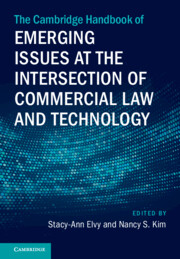Book contents
- The Cambridge Handbook of Emerging Issues at the Intersection of Commercial Law and Technology
- The Cambridge Handbook of Emerging Issues at the Intersection of Commercial Law and Technology
- Copyright page
- Epigraph
- Contents
- Figures
- Tables
- Contributors
- Preface
- Acknowledgments
- Part I Contemporary Technological Developments
- Part II The Implications of Emerging Product Design and Business Models
- 8 E-Commerce Platforms as Product Merchants and Sellers
- 9 3D Printing
- 10 The Right to Repair, Intellectual Property, Exhaustion, and Preemption
- 11 Repairing the Third Wave of Computing
- 12 Ending Smart Data Enclosures
- 13 Behavioral Implications and Emerging Legal Issues in Innovative and Digital Product Design
- Part III Contracting and Dispute Resolution
- Index
11 - Repairing the Third Wave of Computing
from Part II - The Implications of Emerging Product Design and Business Models
Published online by Cambridge University Press: 08 February 2025
- The Cambridge Handbook of Emerging Issues at the Intersection of Commercial Law and Technology
- The Cambridge Handbook of Emerging Issues at the Intersection of Commercial Law and Technology
- Copyright page
- Epigraph
- Contents
- Figures
- Tables
- Contributors
- Preface
- Acknowledgments
- Part I Contemporary Technological Developments
- Part II The Implications of Emerging Product Design and Business Models
- 8 E-Commerce Platforms as Product Merchants and Sellers
- 9 3D Printing
- 10 The Right to Repair, Intellectual Property, Exhaustion, and Preemption
- 11 Repairing the Third Wave of Computing
- 12 Ending Smart Data Enclosures
- 13 Behavioral Implications and Emerging Legal Issues in Innovative and Digital Product Design
- Part III Contracting and Dispute Resolution
- Index
Summary
The past decade has seen a plethora of new product lines in “smart” consumer goods and systems thanks to technological developments that have allowed for the computerization and internet connectivity of many previously “dumb” objects, buildings, and environments. These new products will inevitably develop defects that require resolutions, and add to the ever-growing problem of e-waste. This chapter examines the recommendations of the recent Productivity Commission (PC) Inquiry regarding the “right to repair” (R2R) through the lens of cyber-physical devices and systems, such as the Internet of Things. A stronger R2R for independent repairers (individual, community, or commercial), particularly in the context of these new products, would assist in achieving several of the United Nations’ sustainable development goals. The PC Inquiry has produced some recommendations that will strengthen the R2R in Australia. However, these recommendations, while welcome, also contain some significant gaps in relation to promoting sustainable consumption by consumers.
- Type
- Chapter
- Information
- The Cambridge Handbook of Emerging Issues at the Intersection of Commercial Law and Technology , pp. 230 - 257Publisher: Cambridge University PressPrint publication year: 2025

